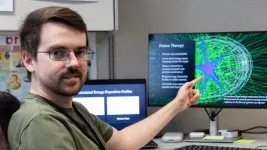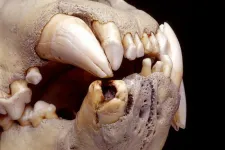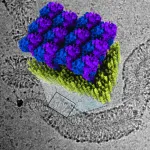(Press-News.org) Researchers have developed and demonstrated a technique that allows them to engineer a class of materials called layered hybrid perovskites (LHPs) down to the atomic level, which dictates precisely how the materials convert electrical charge into light. The technique opens the door to engineering materials tailored for use in next-generation printed LEDs and lasers – and holds promise for engineering other materials for use in photovoltaic devices.
Perovskites, which are defined by their crystalline structure, have desirable optical, electronic and quantum properties. LHPs consist of incredibly thin sheets of perovskite semiconductor material that are separated from each other by thin organic “spacer” layers. LHPs can be laid down as thin films consisting of multiple sheets of perovskite and organic spacer layers. These materials are desirable because they can efficiently convert electrical charge into light, making them promising for use in next-generation LEDs, lasers and photonic integrated circuits.
However, while LHPs have been of interest to the research community for years, there was little understanding of how to engineer these materials in order to control their performance characteristics.
To understand what the researchers discovered, you have to start with quantum wells, which are sheets of semiconductor material sandwiched between spacer layers.
“We knew quantum wells were forming in LHPs – they’re the layers,” says Aram Amassian, corresponding author of a paper on the work and a professor of materials science and engineering at North Carolina State University.
And understanding the size distribution of quantum wells is important because energy flows from high-energy structures to low-energy structures at the molecular level.
“A quantum well that is two atoms thick has higher energy than a quantum well that is five atoms thick,” says Kenan Gundogdu, co-author of the paper and a professor of physics at NC State. “And in order to get energy to flow efficiently, you want to have quantum wells that are three and four atoms thick between the quantum wells that are two and five atoms thick. You basically want to have a gradual slope that the energy can cascade down.”
“But people studying LHPs kept running into an anomaly: the size distribution of quantum wells in an LHP sample that could be detected via X-ray diffraction would be different than the size distribution of quantum wells that could be detected using optical spectroscopy,” Amassian says.
“For example, diffraction might tell you that your quantum wells are two atoms thick, as well as there being a three-dimensional bulk crystal,” Amassian says. “But spectroscopy might tell you that you have quantum wells that are two atoms, three atoms, and four atoms thick, as well as the 3D bulk phase.
“So, the first question we had was: why are we seeing this fundamental disconnect between X-ray diffraction and optical spectroscopy? And our second question was: how can we control the size and distribution of quantum wells in LHPs?”
Through a series of experiments the researchers discovered that there was a key player involved in answering both questions: nanoplatelets.
“Nanoplatelets are individual sheets of the perovskite material that form on the surface of the solution we use to create LHPs,” Amassian says. “We found that these nanoplatelets essentially serve as templates for layered materials that form under them. So, if the nanoplatelet is two atoms thick, the LHP beneath it forms as a series of two-atom-thick quantum wells.
“However, the nanoplatelets themselves aren’t stable, like the rest of the LHP material. Instead, the thickness of nanoplatelets keeps growing, adding new layers of atoms over time. So, when the nanoplatelet is three atoms thick, it forms three-atom quantum wells, and so on. And, eventually, the nanoplatelet grows so thick that it becomes a three-dimensional crystal.”
This finding also resolved the longstanding anomaly about why X-ray diffraction and optical spectroscopy were providing different results. Diffraction detects the stacking of sheets and therefore does not detect nanoplatelets, whereas optical spectroscopy detects isolated sheets.
“What’s exciting is that we found we can essentially stop the growth of nanoplatelets in a controlled way, essentially tuning the size and distribution of quantum wells in LHP films,” Amassian says. “And by controlling the size and arrangement of the quantum wells, we can achieve excellent energy cascades – which means the material is highly efficient and fast at funneling charges and energy for the purposes of laser and LED applications.”
When the researchers found that nanoplatelets played such a critical role in the formation of perovskite layers in LHPs, they decided to see if nanoplatelets could be used to engineer the structure and properties of other perovskite materials – such as the perovskites used to convert light into electricity in solar cells and other photovoltaic technologies.
“We found that the nanoplatelets play a similar role in other perovskite materials and can be used to engineer those materials to enhance the desired structure, improving their photovoltaic performance and stability,” says Milad Abolhasani, co-author of the paper and ALCOA Professor of Chemical and Biomolecular Engineering at NC State.
The paper, “Cationic Ligation Guides Quantum Well Formation in Layered Hybrid Perovskites,” is published in the journal Matter. The paper was co-authored by Kasra Darabi, Fazel Bateni, Tonghui Wang, Laine Taussig and Nathan Woodward, who are all Ph.D. graduates of NC State; Mihirsinh Chauhan, Boyu Guo, Jiantao Wang, Dovletgeldi Seyitliyev, Masoud Ghasemi and Xiangbin Han, who are all postdoctoral researchers at NC State; Evgeny Danilov, director of the Imaging and Kinetics Spectroscopy Laboratory at NC State; Xiaotong Li, an assistant professor of chemistry at NC State; and Ruipeng Li of Brookhaven National Laboratory.
The work was done with support from the National Science Foundation under grant 1936527; and from the Office of Naval Research under grant N00014-20-1-2573.
END
Engineering perovskite materials at the atomic level paves way for new lasers, LEDs
2024-10-11
ELSE PRESS RELEASES FROM THIS DATE:
Kessler Foundation 2024 Survey highlights key strategies for hiring and supporting workers with disabilities in the hospitality industry
2024-10-11
East Hanover, NJ – October 11, 2024 – A new Kessler Foundation survey of supervisors in the hospitality industry – focused on restaurant and traveler accommodations – has revealed critical insights into the recruitment, support, and accommodation of workers with disabilities. The findings, released today in a special live Zoom webinar, offer actionable takeaways for employers looking to diversify their workforce and enhance workplace inclusion. Key points revealed that proactive recruitment, effective partnerships, and ...
Harnessing protons to treat cancer
2024-10-11
NEWPORT NEWS, VA – Radiation therapy techniques have been used for more than a century to treat cancers. Physicists in the Radiation Detector and Imaging group and associated with the Biomedical Research & Innovation Center (BRIC) at the U.S. Department of Energy’s Thomas Jefferson National Accelerator Facility have been for several years pursuing radiation therapy technology improvements in collaboration with the Hampton University Proton Cancer Institute (HUPCI). Now, BRIC physicists are launching a study into how best to advance different types of radiation therapy.
BRIC scientists plan to evaluate the ability of accelerator-based ...
Researchers identify neurodevelopmental symptoms that indicate genetic disorders
2024-10-11
In a new study, UCLA Health researchers have found that motor delay and low muscle tone were common signs of an underlying genetic diagnosis in children with neurodevelopment disorders.
Given the limited existing data on the early neurodevelopmental symptoms that predict a positive genetic diagnosis, the study authors aimed to research which factors in this subset of children indicated the need of a genetic test. “With genetic testing, a diagnostic result can have benefits on medical care, but ...
Electronic nudges to increase influenza vaccination in patients with chronic diseases
2024-10-11
About The Study: In a nationwide randomized clinical implementation trial, electronically delivered letter-based nudges markedly increased influenza vaccination compared with usual care among young and middle-aged patients with chronic diseases. The results of this study suggest that simple, scalable, and cost-efficient electronic letter strategies may have substantial public health implications.
Corresponding Author: To contact the corresponding author, Tor Biering-Sorensen, MD, MSc, MPH, PhD, email tor.biering@gmail.com.
To access the embargoed ...
Plant stem cells: Better understanding the biological mechanism of growth control
2024-10-11
Plants form new leaves, flowers and roots at the tips of shoots and roots, in specific growth regions known as meristems. These meristems contain stem cells that divide as needed and form new cells that develop into specialised tissue. Using the example of plant roots, researchers from Freiburg have now been able to decipher which regulatory mechanisms ensure that growth in the meristem occurs in a controlled manner. The results have been published in the journal Nature Plants.
Stem cells are dependent on ...
Genomic study identifies human, animal hair in ‘man-eater’ lions’ teeth
2024-10-11
CHAMPAIGN, Ill. — In 1898, two male lions terrorized an encampment of bridge builders on the Tsavo River in Kenya. The lions, which were massive and maneless, crept into the camp at night, raided the tents and dragged off their victims. The infamous Tsavo “man-eaters” killed at least 28 people before Lt. Col. John Henry Patterson, the civil engineer on the project, shot them dead. Patterson sold the lions’ remains to the Field Museum of Natural History in Chicago in 1925.
In a new study, Field Museum researchers collaborated with scientists at the University of Illinois Urbana-Champaign on an in-depth analysis of hairs carefully extracted ...
These 19th century lions from Kenya ate humans, DNA collected from hairs in their teeth shows
2024-10-11
By isolating and sequencing DNA in compacted hairs collected from the teeth of two Tsavo lion museum specimens from the 1890s, researchers have found that the historic lions from Kenya preyed on a variety of species, including humans, giraffes, and wildebeests. These so-called “Tsavo Man-Eaters” are estimated to have killed at least dozens of people, including those working along the Kenya-Uganda Railway in the late 1890’s. The findings appear in the Cell Press journal Current Biology on October 11.
“As ...
A potential non-invasive stool test and novel therapy for endometriosis
2024-10-11
Promising findings by researchers at Baylor College of Medicine and collaborating institutions could lead to the development of a non-invasive stool test and a new therapy for endometriosis, a painful condition that affects nearly 200 million women worldwide. The study appeared in the journal Med.
“Endometriosis develops when lining inside the womb grows outside its normal location, for instance attached to surrounding intestine or the membrane lining the abdominal cavity. This typically causes bleeding, pain, inflammation and infertility,” said corresponding author Dr. Rama Kommagani, associate professor in the Department of Pathology ...
Racial and ethnic disparities in age-specific all-cause mortality during the COVID-19 pandemic
2024-10-11
About The Study: In this cross-sectional study of the U.S. population during the COVID-19 public health emergency, excess mortality occurred in all racial and ethnic groups, with disparities affecting several minoritized populations. The greatest relative increases occurred in populations ages 25 to 64. Documented differences deviated from pre-pandemic disparities.
Corresponding Author: To contact the corresponding author, Jeremy Samuel Faust, MD, MS, email jsfaust@bwh.harvard.edu.
To access the embargoed study: Visit our For The Media website at this link https://media.jamanetwork.com/
(doi:10.1001/jamanetworkopen.2024.38918)
Editor’s ...
Delft scientists discover how innate immunity envelops bacteria
2024-10-11
Delft scientists discover how innate immunity envelops bacteria
The protein GBP1 is a vital component of our body’s natural defence against pathogens. This substance fights against bacteria and parasites by enveloping them in a protein coat, but how the substance manages to do this has remained unknown until now. Researchers from Delft University of Technology have now unravelled how this protein operates. This new knowledge, published in Nature Structural & Molecular Biology, could aid in the development of medications ...




